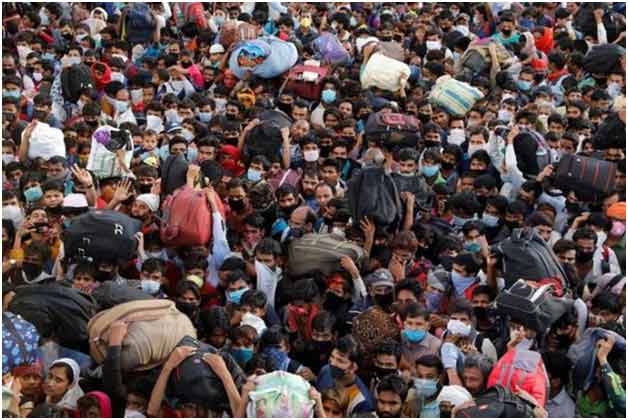
The Government of India on 23rd March 2020 announced a country wide 21-day lockdown. A total of 4 hour was awarded to those in Indian territory to prepare for the lockdown that would strictly remain enforced for three weeks. Prime Minister in his address called this a Mahabharata like war, which will be won in 21 days. Immediately people rushed to stock groceries, masks, sanitizers, etc.
Amongst other vulnerable groups, the government totally forgot to account 50 Million migrant labourers spread all over India, who rely on daily wages for their meal. With no work, scanty or no savings, and no place to stay (as majority of these workers live either at construction sites or at factories where they work), thousands of migrant labourers started their journey back to their villages on foot. The long serpentine trail of human beings, of all age, religion, region, united by their hopelessness and poverty, juxtaposed the 1947 post partition migration crisis. The visible humanitarian crisis forced the government to act, but the help arrived too late and too little.
At the time of writing this Article, we are amidst the 3rd Phase of Lockdown, that is scheduled to conclude on 17th May, and the government has allowed the stranded migrants, stranded students, tourists, etc. to return back to their homes, via government facilitated transport. This decision should have been taken much before announcing the first Lockdown, but albeit late, the decision deserves appreciation.
After the lockdown was announced, a humanitarian crisis unfolded, forcing people into starvation, joblessness, poverty, destitution, depression, etc. This is apart from the health infrastructural crisis where even doctors were not provided with Personal Protective Equipment (PPEs), but this article will stick to highlighting the issues that concern the economy. In my opinion, government’s economic response against COVID-19 is deeply inadequate and is akin to shooting at one’s own foot.
Economists all over the world are advocating the urgent need for a suitable stimulus package to revive the economy. The COVID-19 catastrophe is bound to be at least as bad as 2008 global financial crisis, if not worse. India’s current healthcare expenditure is below 1.5% of GDP, and the sector is marred with a paucity of Doctors, Primary Health Care Centres, Superspeciality Hospitals, Ventilators, Lab Technicians, Pharmacists, medical equipments etc.
What is the situation?
As per the CMIE data, India’s unemployment rate has surged to 27.11% for the week ended May 3 from the level of 6.74% in the week ended March 15. The largest hit in employment is witnessed in unorganized sector and in MSMEs. Several Economists have predicted that India’s GDP Growth will be in negative territory. There is a strong link between disability, loss of employment and impoverishment. Disabilities today have quadrupled, because of destruction of long duration employment and it is now translating into rising poverty. India desperately needs an all-encompassing, well-structured and inclusive stimulus package. United States has announced a package of 10% of its GDP, and, close home, few Asian countries have announced a package of up to 15% of their GDP. While India certainly cannot risk spending in double digits for its stimulus package (because of inflationary risks), but a meagre Rs.1.76 Lakh Crore package, majority of which is repackaged, is woefully inadequate.
What the Government must do?
A meticulous fiscal stimulus plan is needed to boost consumption demand, to cushion the shock and to help the economy revive. The fiscal package must aggressively target those in informal sector and MSMEs. MSMEs must be protected by providing it with a moratorium on loans for 3 months along with interest waiver. This will help the Bank’s balance sheet and the MSMEs will also stay afloat.
The fiscal package must include:
- A direct and unconditional cash transfer of Rs. 2000 per month for 3 months, to the bottom 60% of Indian population. This will create the demand in the economy, which is rapidly shrinking.
- RBI must devise a framework where there is no coercive action on bankers when they lend loans that later become NPAs. A balanced regulation is utmost required to unclog the impending liquidity squeeze in the financial system. Mere rate adjustments will not help. Every sector of the economy is in a dire need of credit.
- All State governments must immediately issue temporary Ration Cards to the bottom 40% of India’s population, and the Union government must order FCI to offload the grains and distribute it amongst the poor. The Current bumper Rabi harvest will refill the FCI godowns.
- The Central government must reduce excise duties on Petrol (by Rs.20 per litre) and on Diesel (by Rs.25 per litre) and pass on the benefits of lower prices of Crude to the consumers ($23.86 a barrel currently).
- The government needs to incentivize the external sector of trade and commerce.
Is it fiscally doable?
Yes, the government will have to delay certain gratifications to do that. The money can be made available if we reallocate some of the budgeted capital expenditure and rationalize expenses. We can certainly defer Central Vista Project and save Rs.20,000 Crore outright and we must stop all less important government advertisements. Beautification projects, statue building etc. must be deferred indefinitely. The Oil bonanza is helping the government have a huge windfall gain for the past six years. The Government has already suspended MPLADS, Dearness Allowances; now, it must bring in a COVID Solidarity tax and shall raise funds by issuing bonds to the public. If nothing, it can always print money. We also don’t have to worry much about the inflationary pressure right now because we have sufficient food stock, a stable foreign exchange and low fuel price.
The government must suit up and announce a fiscal stimulus to the tune of 5-8% of GDP quickly. We have lost a lot of time already, and, we cannot afford being frugal or lackadaisical. Desperate times require desperate solutions. We need to break free from textbook fiscal norms and go beyond the standard practice.
Shariq Us Sabah is a Published Writer, Economist and Policy executive. He can be contacted at [email protected]
SIGN UP FOR COUNTERCURRENTS DAILY NEWS LETTER








































